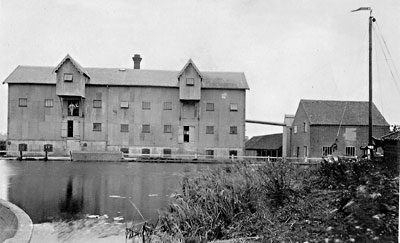 |
|
A
wherry in front of the mill c.1912
|
| Briggate Mill
River Ant / North Walsham & Dilham Canal |
 |
|
A
wherry in front of the mill c.1912
|
|
Briggate watermill
was actually at Worstead and some knew it as Worstead Mill. The name Briggate
appears to have come about via the Norfolk pronunciation of Bridgegate.
The last version of the mill was three storeys high and originally consisted
of weatherboarding set onto the wooden frame that was in turn built into
the brick base of the ground floor. Sadly, the deteriorating weatherboarding
was replaced by grey painted corrugated iron cladding. The foundations,
however, were from an older era. There were three lucums, one of which
was set over the water to take advantage of wherry transport. An eight
foot six inches head of water (advertised as nine feet in 1793) drove a breastshot wheel that was 14 feet
in diameter and 6 feet wide. |
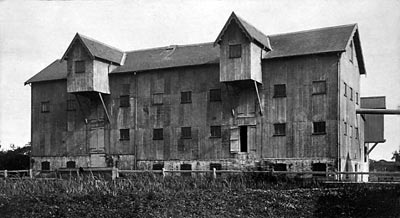 |
c.1912 |
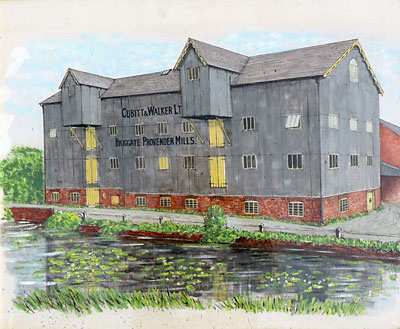 |
Painting of mill c.1926 |
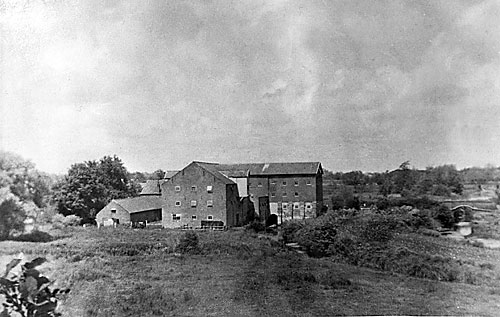 |
Rear of mill c.1926 |
|
Briggate watermill was worked in conjunction with two windmills - first with Worstead Old Mill, which was also known as Briggate postmill then later with Cubitt & Walker's Briggate towermill at Bengate. |
NORFOLK CORN MILLS. WORSTEAD. |
To be Sold |
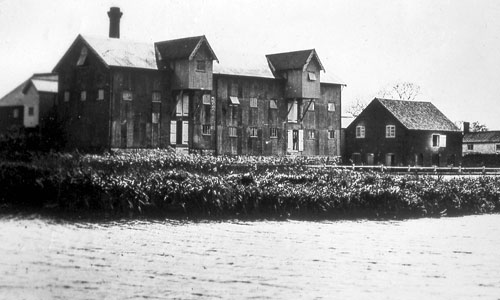 |
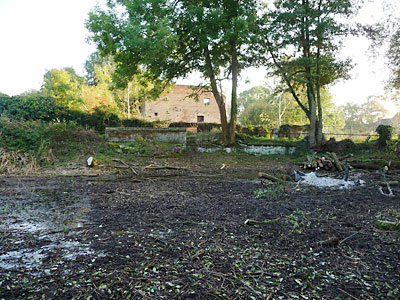 |
|
Mill
dam c.1920
|
Mill dam clearance under way 12th October 2008 |
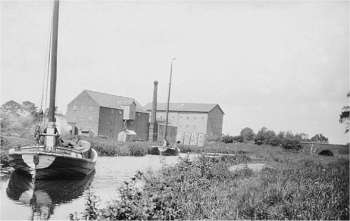 |
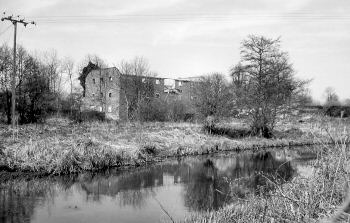 |
|
Wherries
on the canal at Briggate in 1928
|
15th
April 1983 |
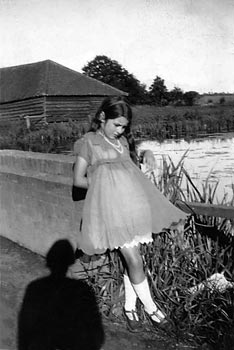 |
Violet Brakenbury near the mill dam c.1932 |
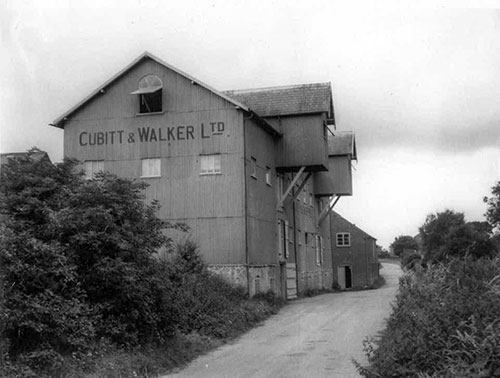 |
c.1950 |
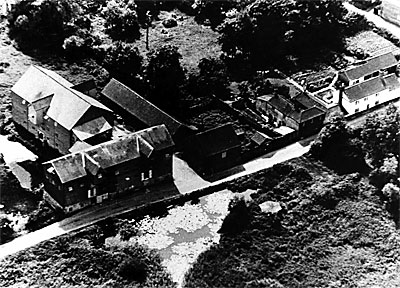 |
Mill site 1959 |
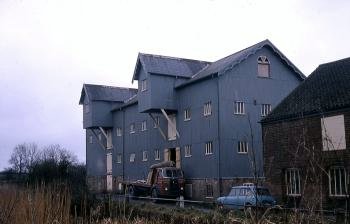 |
|
April
1967 with corrugated iron cladding |
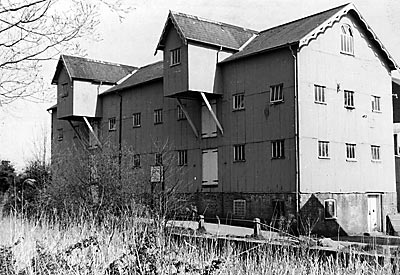 |
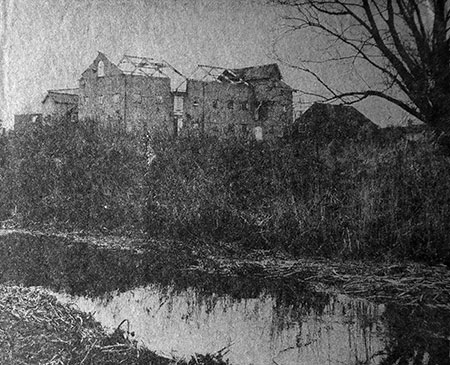 |
1969 |
1973 |
|
Briggate Water Mill burnt down |
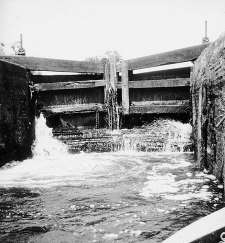 |
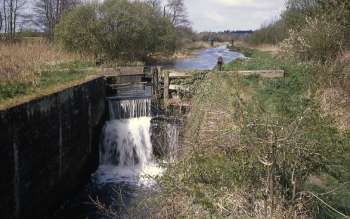 |
|
Briggate
lock 1928
|
Briggate
lock April 1967 |
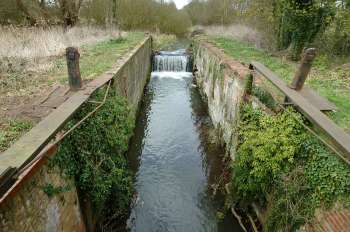 |
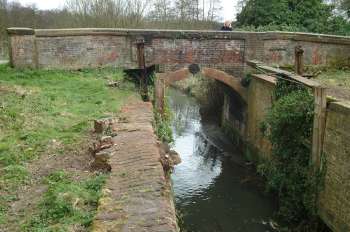 |
|
Briggate
lock 6th April 2003
|
Briggate
lock gates and bridge April 2003 |
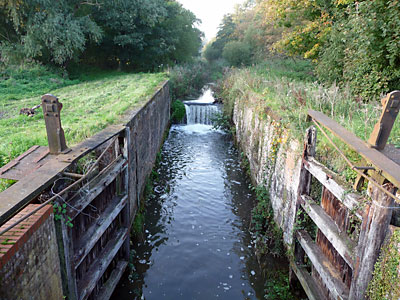 |
Briggate lock 12th October 2008 |
WORSTEAD MILLER'S WRATH |
Take notice. Ten Pounds Reward. Whereas some rascallion or monster of vice or more than one of the accursed race of Cain, did a short time since, steal from my premises a very handsome and well bred cockerel, also a number of hens of the same valuable stock and in excellent condition for the knife. Again on Friday night or Saturday morning, the 19th of June 1830, one or more of the fiends of Hell or enemies of our peace, forcibly entered my mill and stole therefrom a quantity of flour in two sacks marked with my name. If anyone should be so fortunate as to apprehend the villain or villains, so as he or they shall be justly expelled by our good laws from his happy isle, where such are not worthy to exist, to some uninhabited or desolate wilderness where it never will be possible for such to propagate their abhorrent progeny and consequently must weary out their wretched lives without further injuring their fellow mortals, but it is hoped in sincere penitence. The above reward will be given by John Balls, Worstead Mill. Statement issued by John Balls in June 1830 |
|
The North Walsham & Dilham Canal |
This was the
only official canal in Norfolk and was really the canalisation of the River
Ant. It was made wider than most other canals in order to accommodate Norfolk
wherries. The main cargoes were offal to the two Antingham_Bone mills with return loads of fertiliser. Corn and flour moved in
and out of Bacton_Wood and Swafield mills with other commodities such as timber, farm produce and coal making
up the majority of the remainder of trade. It was hoped that coal would
be the mainstay cargo but this never materialised. The canal was just over
8¾ miles long, ran from Smallburgh to Antingham and contained 6 locks:
Honing, Briggate mill, Ebridge mill, Bacton
Wood mill, Swafield lower and Swafield
Upper. 1812: Act of Parliament passed authorising construction of the canal July 1826: Canal opened having cost £32,000 to build 1885: Ailing canal sold for £600 but the company's London solicitor absconded with the money 1886: Scheme introduced to encourage tourist traffic c.1893: Antingham - Swafield section abandoned because of lack of traffic 1934: The wherry Ella, sailed from Bacton Wood Staithe for the last time 2003: Canal navigable for the first 2 miles as far as Honing Lock |
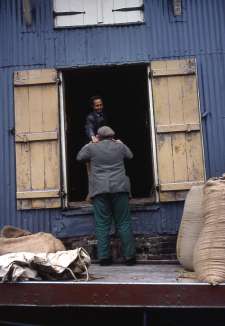 |
|
Billy Baird passing sacks out of the mill
in April 1967
|
|
The North Walsham & Dilham Canal opened in 1826 and was one of the main traffic routes used to bring goods to and from the mill. By 1890 the navigation was in a poor state although it was still possible to reach Antingham Basin. In that same year P. A. Emerson wrote of his voyage "On English Lakes" describing locks in a disgraceful condition, shallow water and excessive weed. When describing Antingham he wrote: "All around there were signs of decaying trade. A deserted granary with rotting doors and rusted hinges, a decaying landing-stage and desolate roads..." Navigation ceased completely in 1935. |
John Roper, lived in a cottage in Whitehorse Lane, Lyngate. |
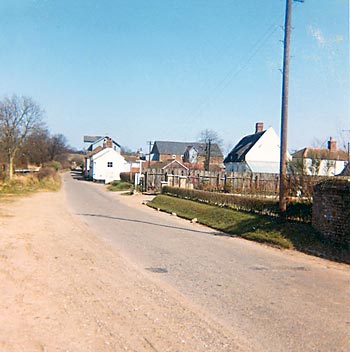 |
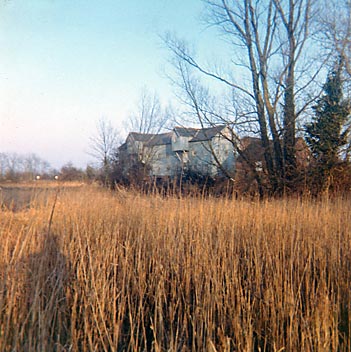 |
Approach to the mill 1969 |
1969 |
In 1890 a steam roller mill was installed and used for many years before being replaced by electricity. |
In the summer of 1890 the granary was destroyed by fire. |
Briggate Mill - a 220 year institution |
As far as it can be ascertained, there has been a mill at Briggate for at least 200 years. White’s Directory of Norfolk, dated 1845, makes mention of a mill and wharf at Bridgegate in the parish of Worstead. Bridgegate or Briggate as it is now called, is one of a number of hamlets which make up the village of Worstead – a place with important associations with the weaving trade. Although the weaving has long since departed from the village, the name “worstead” is still used to describe good woollen cloth. |
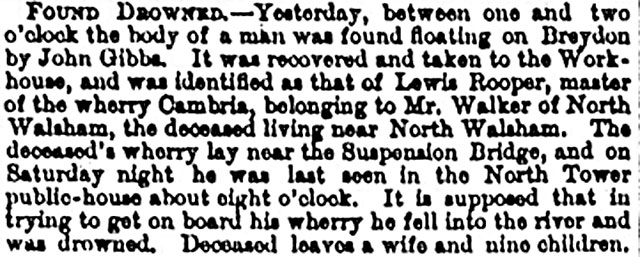 |
Eastern Daily Press - Tuesday 10th January 1888 |
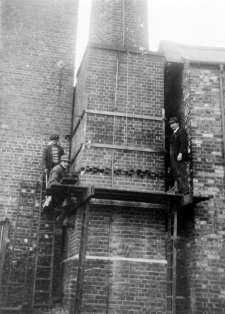 |
|
Steam chimney repairs 1918
|
In 1918 a German Zepplin came over the mill in trouble and to reduce weight, dropped its load of bombs, some of which landed in the meadow at the rear of the Mill. The explosion shook the ground and as the whole area is on peat, transmitted the shake to the Mill. This put the chimney out of plumb. The workmen in the photo are knocking out every other brick on three sides of the chimney. Wedges were then knocked in until the chimney came upright again and the whole bricked back up! A simply solution eh? |
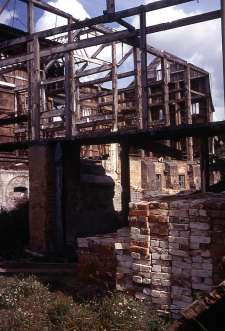 |
|
October
1972
|
|
Six appliances were sent to Briggate Mill, near North
Walsham, late last night. The disused mill was well alight when firemen
arrived with Assistant Divisional Officer Cummings in charge. The three
storey building was badly damaged. |
... Mr. William Partridge Cubitt and Mr. George Walker, then co-partners in the business bought it with about four acres of land from Mr. Thomas Balls, who was living at North Walsham at the time after moving from Worstead, in 1871 for £500. It is understood the property, no longer operational as a mill, was bought by Mr. P. D. Taylor, who was living at Dilham. Then, in July 1972, Mr. J. P. Browne, of Sheriff house, Beech Road Wroxham, in a letter published in the Eastern Daily Press, wrote that he had recently bought the property and surrounding four acres with the intention of ensuring it’s survival by adaptation to changing circumstances as at Buxton Lammas” |
Briggate Mill - ruin or a place to live |
Is the old mill in the hamlet of Briggate, at Worstead, to be a permanent ruin, or will it one day be transformed into attractive houses.The answer to this question is likely to be given by the Secretary of State for the Environment after an inquiry by one of his planning inspectors. Last year, Norfolk's County Planning Officer recommended that the conversion of the mill to homes should be approved, and Smallburgh R.D.C. agreed. Then the district councillors had a change of heart and, on a majority vote, said no. |
Briggate Mill Planning Issues of 1972 - 1975 |
On 2nd March 1973 a report was published in The Journal, a local newspaper regarding the future of Briggate Mill. Anne Grand - 8th January 2008 |
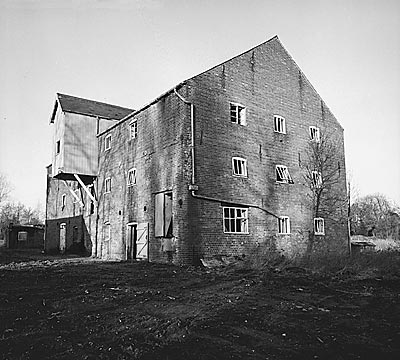 |
The granary 1974 |
The Briggate Mill Fire Conspiracy Case |
The fire that lit the dark skies of the quiet Norfolk village of Briggate, close to Worstead on the night of the 7th August 1975 culminated in one of the longest running court cases in East Anglia lasting 83 days. |
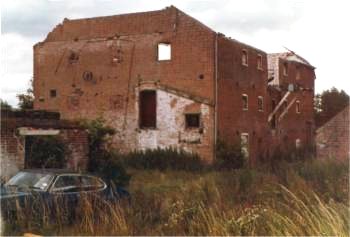 |
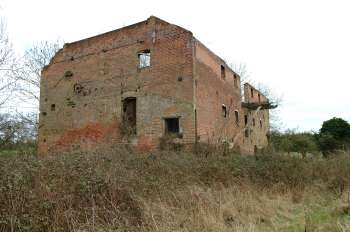 |
Granary mill in 1977 |
Granary 6th April 2003 |
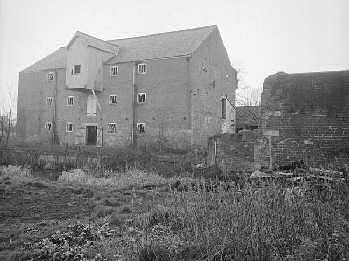 |
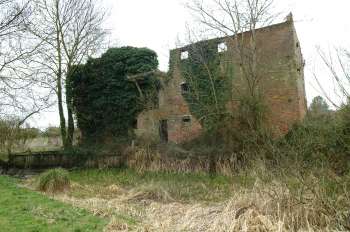 |
|
The
canalside granary mill 1974
|
The
canalside granary April 2003 |
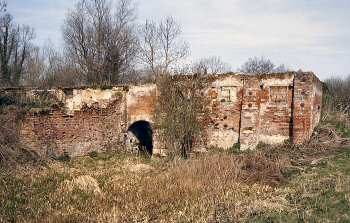 |
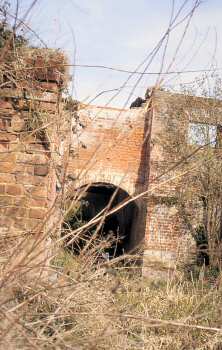 |
|
|
Tailrace arch 15th April 1983
|
Wheelhouse
arch 15th April 1983 |
|
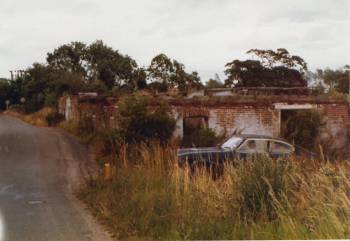 |
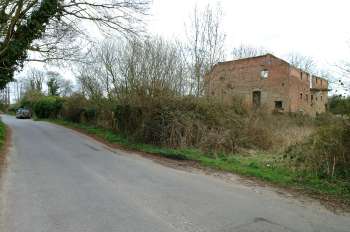 |
|
Road
frontage in 1977
|
Road
frontage 6th April 2003 |
|
Some of the upright wooden posts or columns within the mill were masts from ships that had been wrecked on Happisburgh Sands before being washed up at Bacton and Sea Palling. |
I have taken the following from my mothers notes:- |
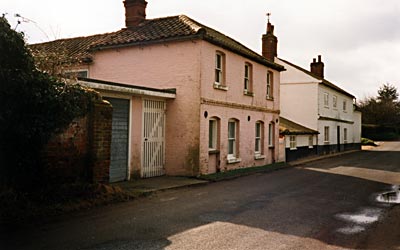 |
Mill House - 1995 |
Alfred Brakenbury bought the Mill House in about 1906. |
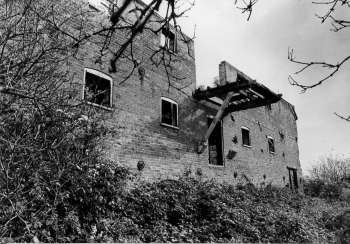 |
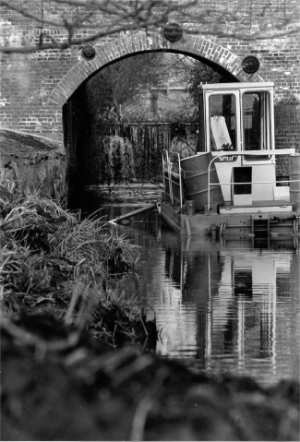 |
|
|
The old buildings becoming overgrown in October 1988
|
Dredging
near the lock 8th May 1993 |
|
On 15th April 1983, plans were discussed that involved redigging the filled in mill dam, rebuilding the remaining structure and opening it as a papermill. The mill wheel or a turbine would be reinstated to generate electricity. |
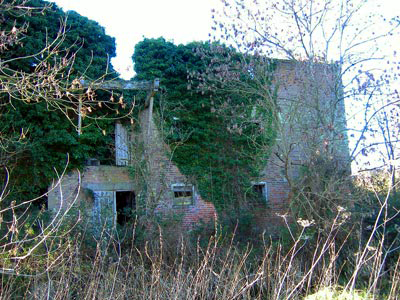 |
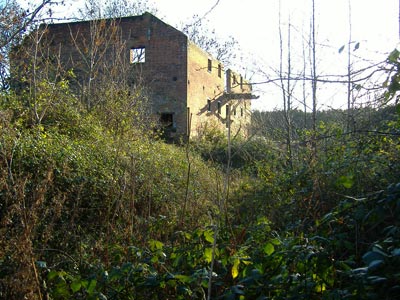 |
Granary from the canal side 1st January 2007 |
Granary from the road 1st January 2007 |
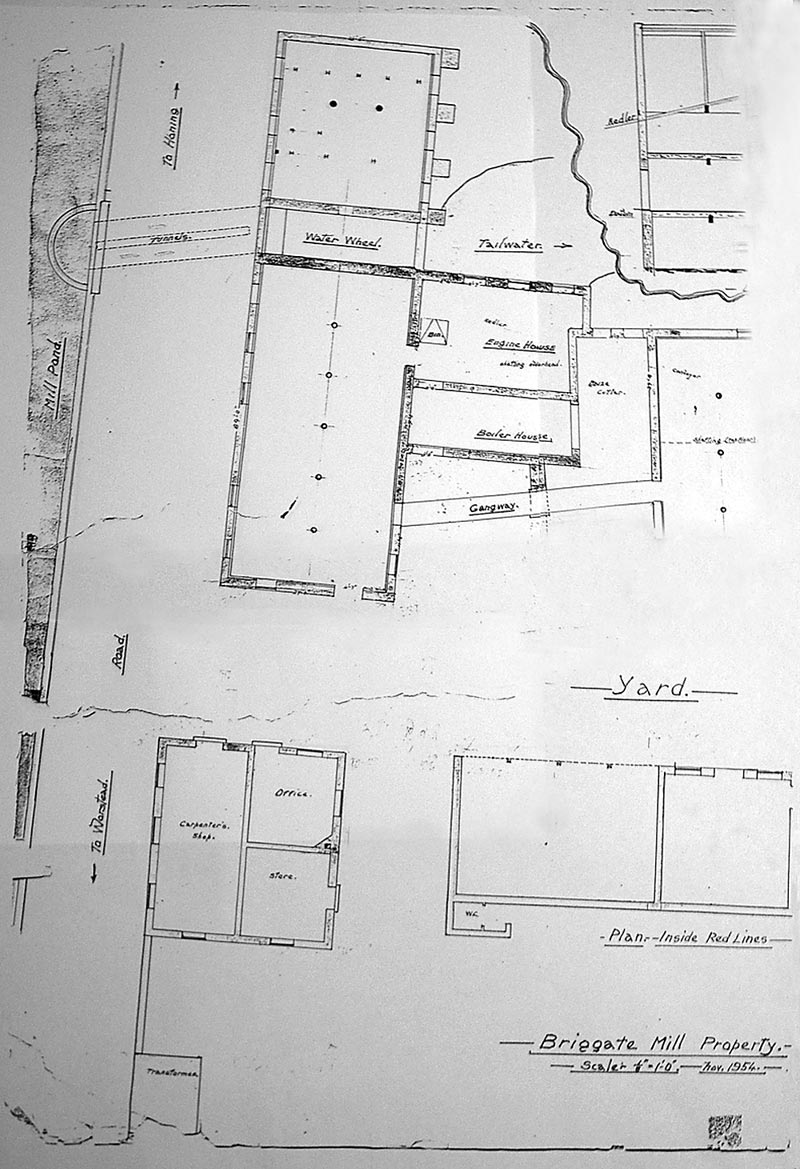 |
Mill plans - November 1954 |
Memories of Briggate Mill |
Michael Willis was born in 1939 at Briggate. He worked full-time at Briggate mill for a few years around 1958/9 but his memories of the mill go back to when he was 3. His Mother worked as a school teacher and Michael was looked after by Hilda Hall (Jo) who would often push him in his pram down to the mill where his father worked and the men at the mill made a fuss of him. As he got older he played there and helped his father Leonard Willis, who was a miller at Briggate, as was his grandfather Charles Willis before him. Before long Michael started working there on Saturdays and whenever his father needed additional help.
Briggate mill Notes Charlie Willis (grandfather) - a miller at Briggate, he died towards the end of the war in the 1940’s by then he was in his 80’s He had three sisters Margaret (Polly), died about 1955 in 80’s / 90’s Sally (Sarah) who died around the same time at around the same age and Mary all of whom were in service at one time. There is a Mary Willis recorded on the Census 1851 as: Mary Willis (19) b. Mautby. House servant, West end Ormesby St Margaret It is possible that she is the sister Mary but this has not been confirmed. Leonard Willis (father) born 1901 White Horse Lane, Briggate Father left school at 12 became a gardener’s boy, not for long before working at the mill for 51 years. He was made redundant just before he was 64 when operations went to Ebridge. He always used to say “Food was pasteurised, sterilised or buggered up.” |
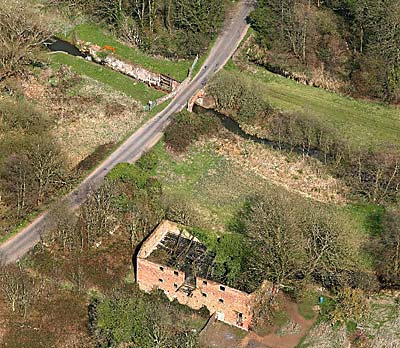 |
5th April 2007 |
It was reported that a new resident, David Turner, moved into the village during the summer of 2007 and susequently allegedly 'land grabbed' the mill and an area on the opposite side of the road that used to be the mill dam. A security fence was then erected around the mill. On 5th January 2008 a digger moved in to start clearing the undergrowth and the mill surrounds, much to the consternation of the local residents. |
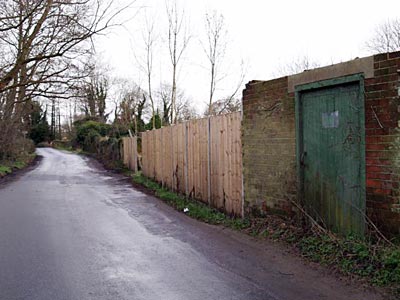 |
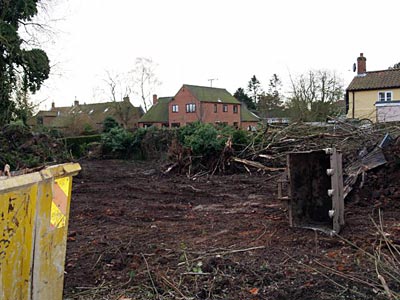 |
Security fence surrounding the mill site 5th January 2008 |
Site clearance in progress 5th January 2008 |
The canal cut next to mill site was apparently the only known habitat in England of the Black Water Vole and the clearance of the mill site threatened its existance as it was reported that a considerable amount of debris ended up in the canal. |
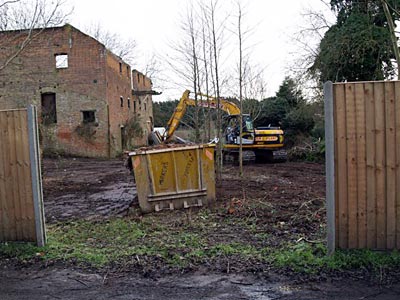 |
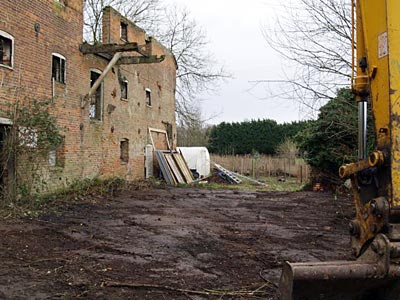 |
Site clearance around the granary in progress 5th January 2008
|
|
Villagers fear mill ‘land grab' |
A disused mill near North Walsham is at the centre of a row which has involved the police, the district council, villagers and North Norfolk MP Norman Lamb. Villagers living near Briggate Mill, which has been empty for decades, claim it is about to be “land grabbed” by someone who does not own the site. Police have been called to the site to investigate claims of damage to the land and North Norfolk District Council has been asked to look into a raft of issues, including high fencing, the presence of a polythene tunnel and if there are any tree-preservation orders on the site. The damage claims come after a digger was used to clear part of the site at the weekend. It is not clear who is behind what has been happening and the ownership of the site is uncertain, although villagers believe they know who is responsible. District councillor Cath Wilkins said: “This is not the first time someone has tried to claim ownership of Briggate Mill but in this case it has gone further than ever before with the damage that occurred to the land at the weekend. “It is an environmentally sensitive area, with otters, voles and many other species present. People are very upset, something has to be done.” Mexeena Carlos, who was born and brought up in the tiny hamlet of Briggate, said she and the other villagers were “devastated” at what had happened. “We are putting together a petition and getting help from as many people as possible.” Mr. Lamb said he felt his constituents appeared to have legitimate and serious concerns about a “sensitive and valuable site”. Eastern Daily Press - Wednesday 9th January 2008 |
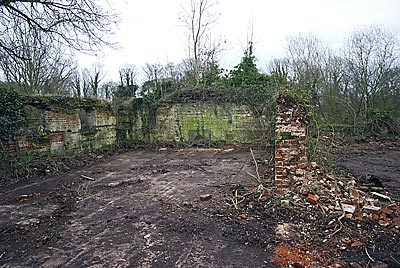 |
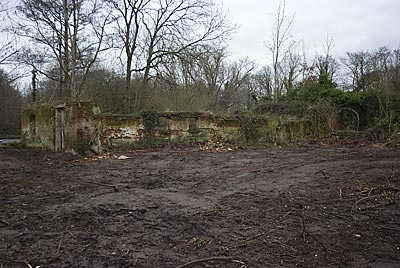 |
Interior of watermill 13th January 2008 |
Site cleared around remains of watermill 13th January 2008 |
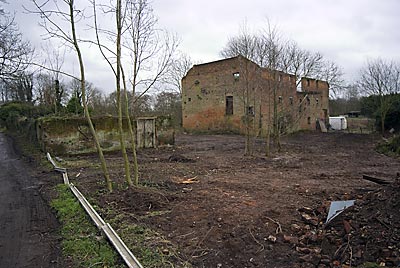 |
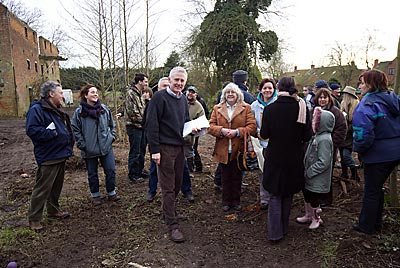 |
Remains of security fence 13th January 2008 |
Norman Lamb MP and Cath Wilkins of NNDC - 13th January 2008 |
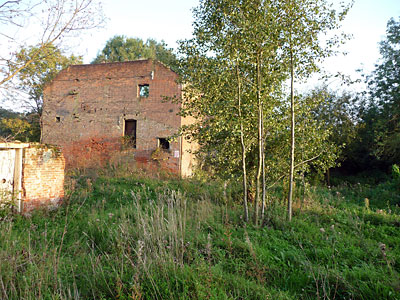 |
Site wildlife regeneration 12th October 2008 |
Planners will
probe use for
polytunnel |
A controversial application to allow a
polytunnel to remain on land close to
a disused mill has been deferred so
planning officers can investigate
what it is to be used for. The tunnel has been put up on land next to Briggate Mill in the small hamlet near North Walsham. David Turner, whose garden adjoins the site, applied for permission for the tunnel after it was reported by district councillor Cath Wilkins. Having remained empty for decades, villagers living nearby claim the Briggate Mill site is being land-grabbed by someone who does not own it. In recent months, police have been called to investigate claims of damage to the land and North Norfolk District Council has been asked to look into a raft of issues. But at a meeting of the district council’s planning committee, legal enforcement officer Roger Howe said none of the controversy over ownership could be taken into consideration. He said: “Issues of land ownership and civil disputes are not relevant to the application and we should not get involved in adverse possession claims.” Joanne Gardner, clerk of Worstead Parish Council, said the tunnel was an eyesore and was obtrusive and asked the council to consider an environmental impact assessment on the site. Speaking as local member for Worstead, Cath Wilkins said the tunnel was ugly and “brought the whole area down”. With questions being raised by several councillors on whether the polytunnel was being used to store filing cabinets, it was decided to defer any decision until officers could establish the intended use. If the tunnel is not intended for horticultural purposes, a change-of-use application will be required. Eastern Daily Press - 4th April 2008 |
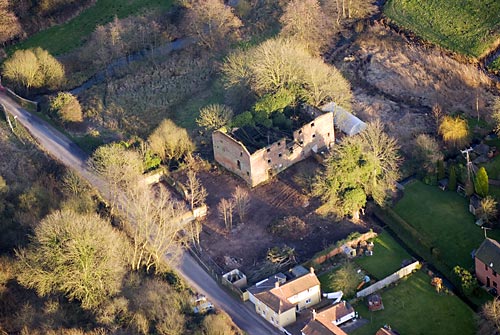 |
9th February 2008 |
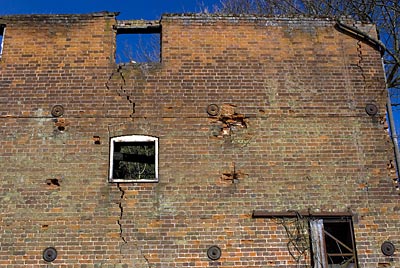 |
Brickwork apparently believed to be safe by North Norfolk DC in January 2008 |
The North Walsham and Dilham Canal Trust has today Sunday 19th starting to remove trees from the mill pond. with a view to open it up again. A tree surgeon will take the big ones down for Honing Estate as they are part of the Canal company. Also, on 8th August, on the other side of the road the wall between the Mill Cottage and sub station was hit by a drink/drive 5 times over the limit knocking part of it down. |
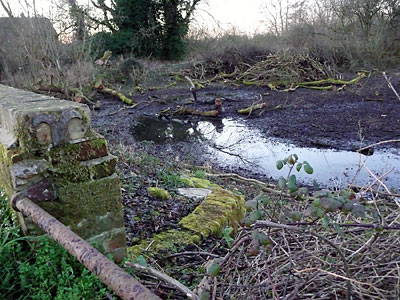 |
Blocked inlet from filled in dam to wheelrace 2nd January 2009 |
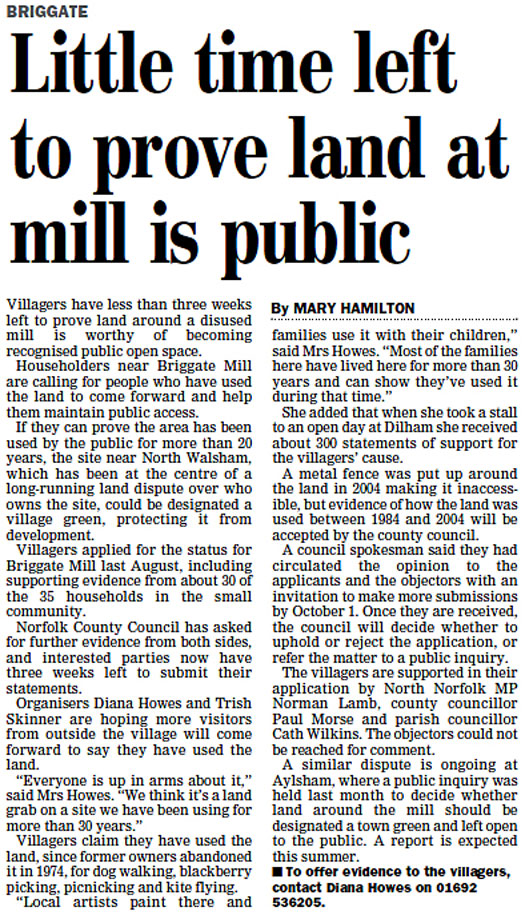 |
Eastern Daily Press - 16th September 2009 |
A long-running dispute which could
see an area of land around a disused
Norfolk mill recognised as a public
open space and protected from
development will be assessed at a
public inquiry in July. |
Briggate Mill was destroyed by fire on 7th August 1975, since then
residents of Briggate and many visitors have had free access to the
open land around the mill. Activities over the years included children
playing, pond dipping in the watercourse and mill race, dog walking,blackberry and elderberry picking and lots more. |
Briggate Mill inquiry location victory |
| The location of a public inquiry which will decide whether an area of land around a disused Norfolk mill will be recognised as a public open space and protected from development has been changed - to the delight of campaigners. The "village green" inquiry for the land around Briggate Mill was originally to be held at Norfolk County Council's County Hall headquarters in Norwich, a decision which angered villagers. It also led them to claim it would impact on their efforts because most witnesses and supporters, many of them elderly, would not be able or prepared to make a time consuming and sometimes difficult 40 mile round trip to give their evidence. But that decision has been reversed and the hearing will be held at Worstead Village Hall, half a mile from Briggate, instead. Previous village green application inquiries around Norfolk have been held locally rather than at the council's headquarters and the change in the established practice had been put down to the need to save council costs and staff time. The two-day hearing will be held on the same dates as originally announced, July 12 and 13. The hearing will assess claims that the land in question has been used by the public for more than 20 years, with first-hand evidence from people attending playing a key part alongside written submissions. Campaigner Diana Howes said: "We are delighted by the change in venue, it is a brilliant result. "We have been supported enormously by our local county councillor Paul Morse and Worstead Parish Council, and we are very grateful to them. "We know we will get many more people to attend now it is on the doorstep rather than a lengthy journey away." Mr Morse said: "To me Worstead is the right place to have the inquiry, things like this should not be in remote, formal buildings." Villagers claim they have used the land for dog walking, blackberry picking, picnicking and kite flying, among other uses, since former owners abandoned it in 1974. County council spokesman John Birchall said they had decided the extra cost "was reasonable for the convenience of local people" and thanked the village hall's booking clerk for taking the booking. |
Briggate's village green bid fails |
|
A bid by hamlet residents to have land around a ruined north Norfolk water mill registered as a village green has ended in failure, after a three-year battle and a public inquiry. Residents in Briggate, near North Walsham, learned this week that inquiry inspector Vivian Chapman has rejected their application because he felt they had not proved locals had been using the site for sports and pastimes throughout a 20-year period. The tiny community, of just 36 homes, had mounted the bid after alleged attempts at land grabbing around the mill whose ownership is unclear. Diana Howes, who made the village green application, backed by dozens of other villagers, has pledged to keep fighting to ensure the site is protected from possible future land-grabbers. "I'm very disappointed but I half expected it. It's very difficult to get this sort of thing passed," said Mrs Howes. She added: "There are alternatives however and I will be exploring 'Plan B' with county councillor Paul Morse who has been supporting us." In July Mr Chapman took evidence from 13 villagers who attended the inquiry in Worstead, held under the auspices of Norfolk County Council. They sought to prove that the land had been used for a range of leisure activities between 1984 and 2004. But Mr Chapman decided that by about 1994 only a rough track was reasonably accessible which meant the community could only have been using the land as a right of way rather than a village green. Mr Morse praised the efforts of Mrs Howe and her supporters. He said: "It was a huge community effort to try and get this registration and the outcome is a great shame, but not unexpected, because the legislation is very complex and relies a lot on case law. There is no reason why, given that the owner is nowhere to be found, local people can't keep trying to preserve it as an amenity. All is not lost. We need to move forward and look at other possibilities." Application objector Yvonne Bullimore, who used to own a home in Briggate with her partner David Turner, did not attend the inquiry but submitted written information. |
Breakthrough at troubled mill |
|
Water is once again running into the millpond at Briggate after its link to the North Walsham and Dilham Canal was restored following three years of effort to clear the area. The development marks a new and positive chapter in the eventful history of the mill, near North Walsham, which was at the centre of a famous court case and, more recently, an unsuccessful community campaign. Volunteers working with the East Anglian Waterways Association and North Walsham and Dilham Canal Trust, hope their restoration efforts will attract wildlife back to the pond. They also aim to preserve Norfolk's only canal, which stretched nine miles from Antingham, near North Walsham, to the Smallburgh River near Wayford Bridge when it was opened in 1826. The last wherry sailed the water in 1934. Briggate millpond dried up in the 1970s and its boundary became hidden under thick shrubbery and trees, according to work party organiser David Revill. In its heydey, wherries visited the millpond carrying goods to and from Briggate and Worstead. Water began running again after a final sod was removed from a newly-dredged channel linking the canal to the partially-cleared millpond. Volunteers are back at Briggate this week trying to dredge and re-water as much of the original pond as possible before the nesting season begins. The mill, which closed in 1969, lies over the road from its pond and volunteers hope their work will eventually allow the water to flow through the linking mill race once again. In 1975, the mill was burnt down in an insurance fraud, which saw four men jailed after an 83-day trial. During the trial it was revealed that one of the defendants had links with notorious criminals, the Kray twins. After years of uncertainty over ownership and alleged land-grabs, Briggate residents learned last summer that their application to have land around the mill registered as a village green had not been granted. An inspector decided, following a three-year battle and public inquiry, that the community had not proved its use for sport and pastimes throughout a 20-year period. But residents are continuing to look after the site and have been helping the work parties, according to leading campaigner Diana Howes. They hope to preserve the area as a nature reserve, but are waiting for advice from North Norfolk District Council about the state of the granary building which has developed large cracks over the winter. The site is one of six along the canal where volunteers have been working to stabilise deteriorating locks and clear choked waterways. Clearance has also helped alleviate flooding problems in North Walsham, which relied on the canal as a major drain, said Mr Revill. Last year, work parties started dredging the pond at Ebridge_Mill and soon afterwards watched a duck dive into the water followed by her six ducklings. Mr Revill said: "It makes it all worthwhile when you see that what you're doing is reaping those sort of benefits." To join work parties, ring 01603 738648. Alex Hurrell, North Norfolk News - Thursday 10th February 2011 |
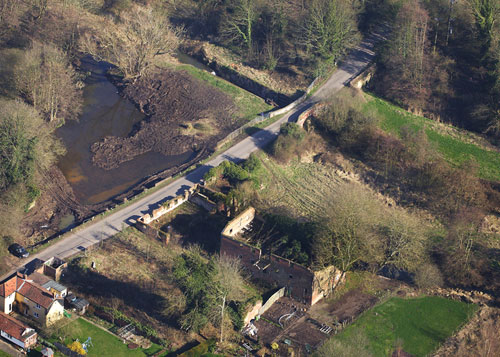 |
Newly reflooded mill dam 7th March 2011 |
Since November 2010 the hamlet has been working with the North Walsham & Dilham Canal Trust and have taken over the mill land, (but not the granary building). We hope some day to have the land registered with the Land Registry. With the Mill pond now dug out and the mill race being worked on, the whole area begins to look interested again. As no owner can be found for the granary building, it is up to the District Council to do something about it. They have been out here 3 or 4 times to have a look, we are now waiting for them to say what they will do. The weather got into the building this winter and a lot more bricks have be coming down at the far end. We have been working with the new owners of Millbeck (after Bullimore/Turner left the hamlet in Dec 2009) and the new owners are very nice. |
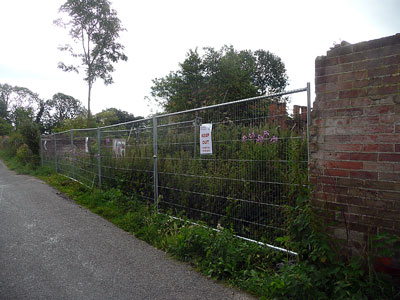 |
Site fence erected 6th July 2011 |
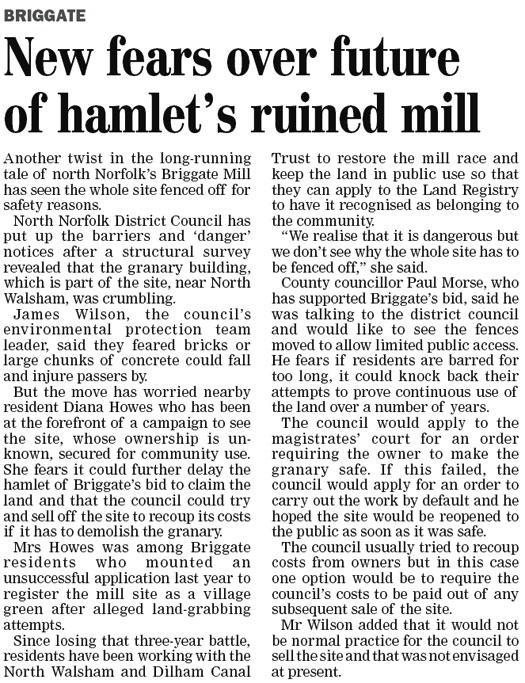 |
Eastern Daily Press - 24th August 2011 |
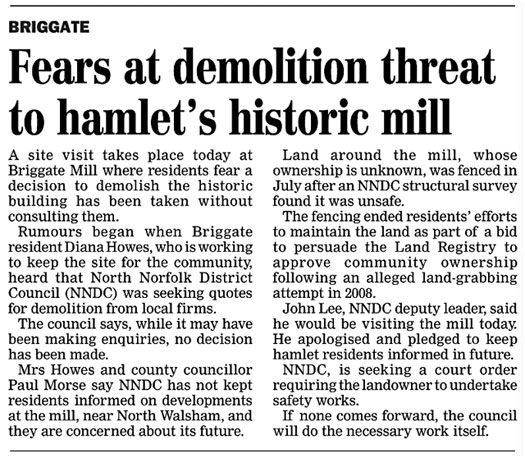 |
Eastern Daily Press - 31st October 2011 |
Fresh hope in hunt for long-missing owner of Briggate Mill, near North Walsham |
The long-missing owner of a north Norfolk mill with a colourful history may have been traced, it has been revealed. |
Court application is made by North Norfolk District Council to find owners of "dangerous" Briggate Mill |
The application was formally made by North Norfolk District Council at Norwich Magistrates Court this morning as enquiries have not been able to ascertain the owner of Briggate Mill, near Honing. |
Briggate Mill pond, on the North Walsham and Dilham Canal, |
Egrets, kingfishers, frogs, mallards and fish are among the wildlife now able to enjoy a restored section of Norfolk's only canal. |
Legal bid fails to find owner of Briggate Mill, near North Walsham |
Work to ensure the safety of a historic mill will be carried out by North Norfolk District Council (NNDC) after the failure of a legal bid to find the derelict building's owner.
|
| N.B. The structure in question is not the mill. which burnt down in August 1975, it's the granary. JJN |
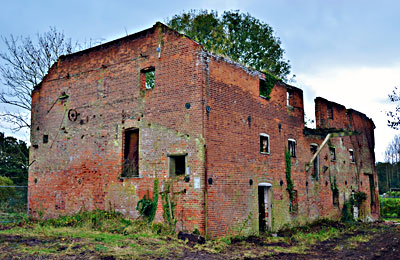 |
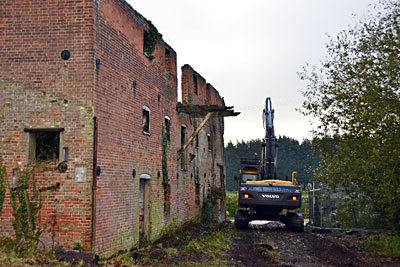 |
Briggate granary Tuesday 30th October 2012 |
Preparing for demolition Tuesday 30th October 2012 |
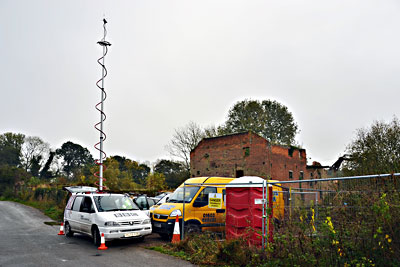 |
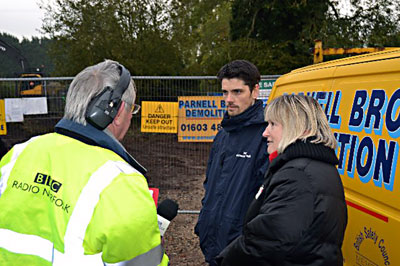 |
BBC Radio Norfolk's radio car Tuesday 30th October 2012 |
Honing PC chairman, Diana Howes being interviewed by Wally Webb of Radio Norfolk, Tuesday 30th October 2012 |
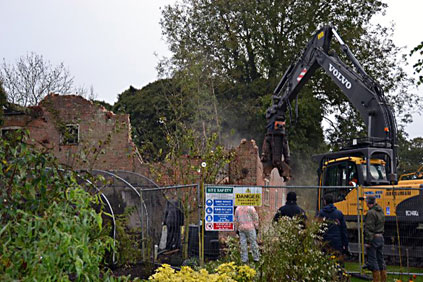 |
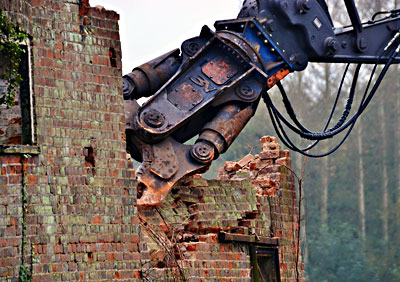 |
Demolition underway Tuesday 30th October 2012 |
Nibbler unit Tuesday 30th October 2012 |
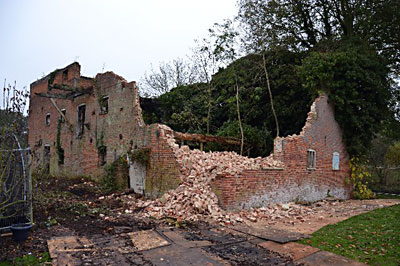 |
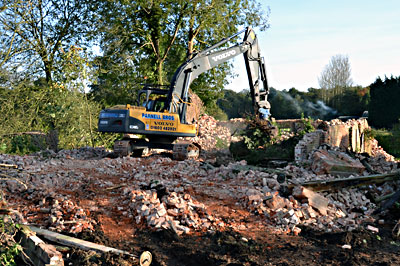 |
Pause in demolition Tuesday 30th October 2012 |
Demolition almost complete Tuesday 30th October 2012 |
Demolition under way at Briggate Mill |
An historic north Norfolk landmark is rapidly disappearing this week as a demolition crew sets about flattening Briggate Mill. |
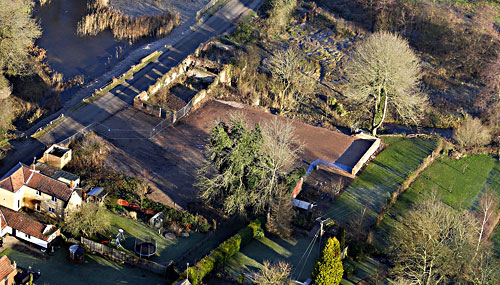 |
12th December 2012 |
| I was about 18 at the time of the fire, and living with my parents in White Horse Lane. It was fairly dark, and in a short time the fire leaped up from 'average' sized flames to massive streams of flame hundreds of feet in the air - it was extremely bright and noisy, and we were worried and puzzled too at the time. How could a watermill burn so ferociously? It made no sense. Fire engines arrived, then more engines, then more... again, amazing to see ten or more fire engines crammed into the tiny village roads. We stayed outdoors for quite a while but did not go too close as it was pretty easy to see the flames while standing in White Horse Lane. I went through a lot of changes in my life in that 'sleepy' village and still remember some of them, but the Fire is definitely a big memory of the old days. Bill Dady - 6th May 2019 |
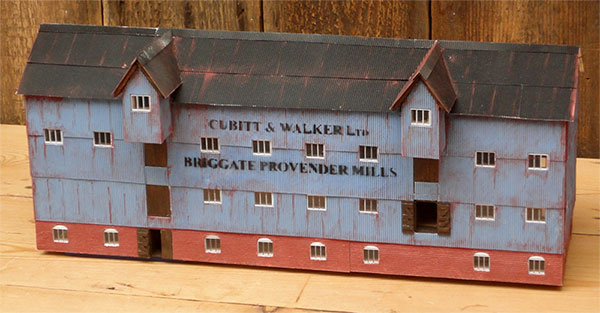 |
Model of later mill structure by Michael Hewitt - May 2019 |
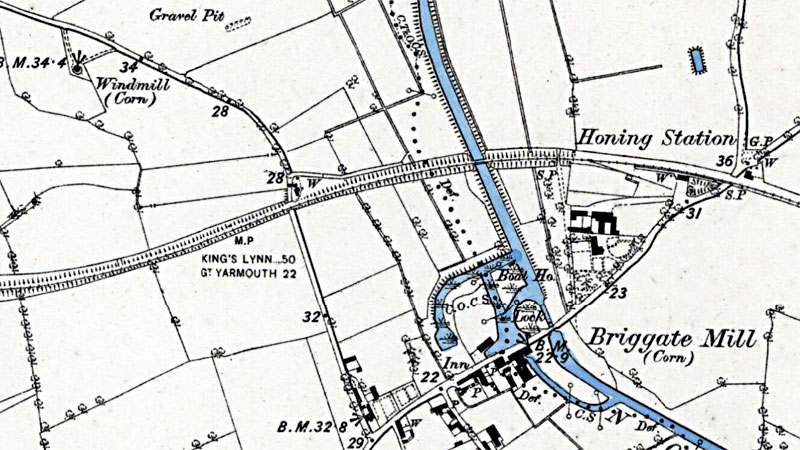 |
6" O. S. Map 1885 (not to scale) |
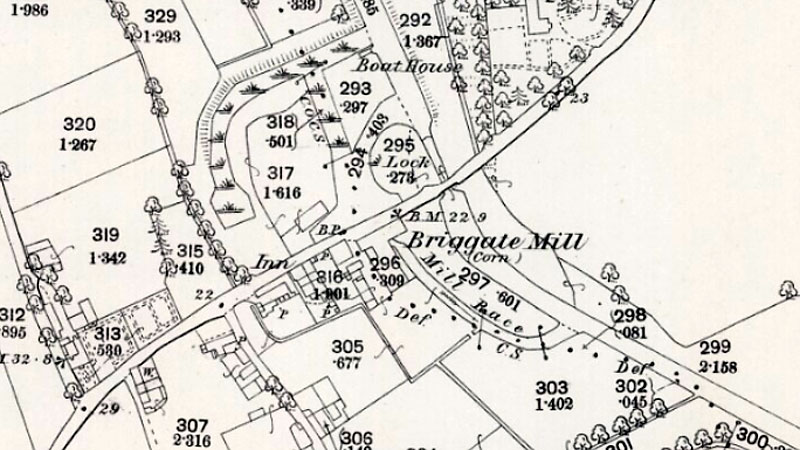 |
25" O. S. Map 1885 (not to scale) |
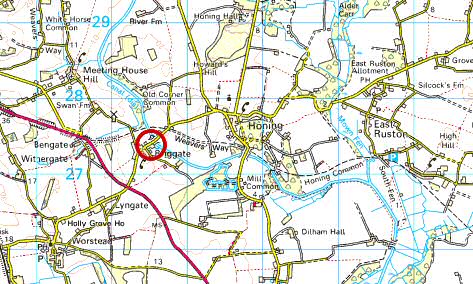 |
O.S. Map 2005 Image reproduced under licence from Ordnance Survey |
|
Worstead index
of wills 1720: James Broune
White's 1845: Christopher Sadler, miller, Bridgegate
Census 1851: Benjamin Ramm (26) miller (employee)
White's 1883: Cubitt & Walker, millers & c., and at North Walsham
1903: Granary converted to grist mill to take over from the windmill after it lost its sails in a gale.
5th January 2008: Mill site around existing buildings levelled |
If you have any memories, anecdotes or photos please let us know and we may be able to use them to update the site. By all means telephone 07836 675369 or
|
| Nat Grid Ref TG 31542740 | Copyright © Jonathan Neville 2004 |